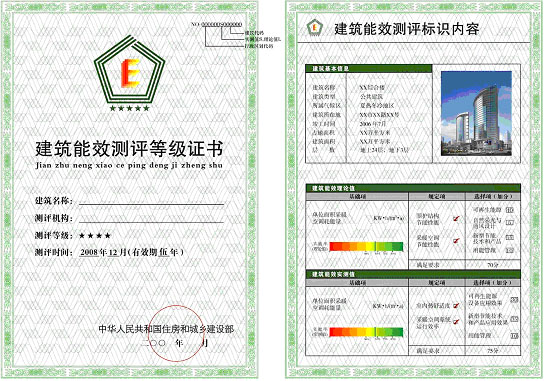

[concept]
Energy efficiency evaluation refers to the activity of calculating and testing the performance indicators such as building energy consumption and the efficiency of energy consumption system, and giving its level. [1] In the process of energy efficiency evaluation, the energy efficiency level of buildings shall be checked and calculated according to the relevant standards and technical requirements of building energy efficiency. If necessary, it shall be tested and evaluated. According to the results of building energy efficiency evaluation, the building energy efficiency evaluation mark shall express the building energy efficiency level in the form of information mark.
The evaluation mark of building energy efficiency takes a single building as the object, and includes the pipe network and cold and heat source equipment associated with the building. The energy consumption equipment of residential buildings mainly refers to heating and air conditioning system, and the energy consumption equipment of public buildings mainly refers to heating and air conditioning system and lighting; Facilities generally refer to the service system matched with the equipment and set up to meet the needs of equipment operation. Based on the review of relevant documents, performance test reports of parts and components and on-site random inspection, combined with the calculation and analysis of building energy consumption and the measured results, the comprehensive evaluation is carried out.
(1) Energy efficiency evaluation: calculate, check and test the performance indicators reflecting the energy consumption of buildings and the efficiency of building energy consumption system, and give the activities of their level.
(2) Measurement and evaluation of building energy efficiency: measure the actual energy consumption of buildings, and conduct on-site detection and judgment on the efficiency of building energy consumption system.
(3) Building energy efficiency label: an activity that expresses the information related to building energy consumption to the society or the owner of property rights according to the evaluation results of building energy efficiency.
[meaning]
According to the regulations on energy efficiency of civil buildings, the owners of office buildings and large public buildings of state organs shall evaluate and mark the energy utilization efficiency of buildings, publicize the evaluation results in accordance with relevant national regulations and accept social supervision.
According to the Interim Measures for the administration of energy efficiency evaluation and labeling of civil buildings, the following civil buildings shall be marked with building energy efficiency evaluation and labeling:
(1) New (reconstructed or expanded) office buildings of state organs and large public buildings (with a single building area of more than 20000 square meters);
(2) Office buildings and large public buildings of state organs that implement comprehensive energy-saving transformation and apply for financial support;
(3) Buildings applying for national or provincial energy-saving demonstration projects;
(4) Buildings applying for green building evaluation marks.
[grade identification]
The applicable objects of building energy efficiency signs are new residential and public buildings and existing buildings after energy-saving transformation. The evaluation object is a single building. The building energy efficiency label is divided into five grades, with 50 ~ 65% energy saving as one star, which is an energy-saving standard building; Energy saving 65 ~ 75% is two stars; Three stars for energy saving of more than 75-85%; More than 85% of energy saving is four-star. If the score of the option (for projects with energy consumption system and process technology higher than the current national building energy efficiency standard) exceeds 60 points (out of 100 points), another star will be added.
The evaluation mark of civil building energy efficiency is divided into two stages: the theoretical value mark of building energy efficiency and the measured value mark of building energy efficiency. The energy efficiency evaluation of new buildings shall be carried out after the acceptance of divisional works of building energy conservation and before the completion acceptance of buildings. The actual measurement and evaluation of building energy efficiency shall be carried out after 1 year of normal use of the building and when the occupancy rate is greater than 30%. The identification of the theoretical value of building energy efficiency shall be corrected according to the measured results, and the identification results of the measured value of building energy efficiency shall be given, which is valid for 5 years.
[incremental work involved in energy efficiency evaluation]
(1) Demonstration and analysis of energy consumption level of the project;
(2) On site verification and inspection of energy-saving technical measures of the project;
(3) Preparation and approval of energy efficiency evaluation report.
[consultation service process of energy efficiency evaluation]
(1) Collect and sort out the contents and data related to energy consumption in the relevant drawings of each discipline of the project, and formulate the energy efficiency evaluation scheme;
(2) According to the scheme and collected materials, establish the mathematical model of energy efficiency evaluation, calculate the energy efficiency, and evaluate the theoretical value of energy efficiency;
(3) Carry out on-site verification and inspection according to the construction drawings of various disciplines and design energy-saving technical measures, and form verification records;
(4) According to the energy efficiency calculation results and on-site verification records, prepare and issue the energy efficiency evaluation report and submit it to the competent department for review;
(5) Modify and improve according to the audit opinions to meet the requirements of energy-saving acceptance.
[consulting results of energy efficiency evaluation]
(1) Calculation model of energy efficiency evaluation;
(2) Energy efficiency evaluation report.
[relevant basis]
(1) Regulations on energy conservation of civil buildings
(2) Interim Measures for the administration of energy efficiency evaluation and labeling of civil buildings
(3) Technical standard for building energy efficiency labeling
(4) Detailed rules for the design and implementation of energy-saving buildings in various provinces and cities
[Sample Certificate]

